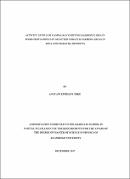Activity levels of gamma ray emitting radionuclides in food crop samples in selected tobacco farming areas in Aura and Maracha districts
Abstract
The farming activities, especially Tobacco production in Terego East and Terego West
in Arua district and Maracha East County in Maracha district employ fertilizers such as
NPK, DAP, CAN, TSP and UREA to enhance soil fertility property and to increase
Tobacco production. Fertilizers are known to contain radionuclides such as uranium,
radium, potassium etc., that originate from phosphate rocks; that could accumulate in
the soil over the years and these may be absorbed by food crops grown on such soils.
Humans who feed on these food crops may then absorb such radionuclides. As Human
cells absorb radiation energy, molecules in them get damaged resulting into malfunction
of cells through genetic mutation and this can then be a health risk.
in this study the specific activity levels of gamma ray emitting radionuclides in selected
food crop samples (maize, rice, sorghum, cassava, ground nuts, beans and simsim),
grown in soils contaminated by fertilizers was determined using Gamma ray
spectroscopy technique, that uses Nal(Tl) detector. The samples were obtained from the
six Sub Counties of Omugo, Aii-vu, Odupi, Oriama, Katrini and Bileafe in Arua District
and three Sub Counties of Tara, Yivu and Nyadri in Maracha District. The sampling
technique used was purposive and simple random. In summary, the mean specific
activity levels of radium, thorium, uranium and potassium were 64.0 Bqkg·1
, 6.0Bqkg·1,
3.5 Bqkg·1 and 185.1 Bqkg·1 respectively, in the crop samples considered. The mean
specific activity levels for potassium was the highest, followed by radium, thorium ·and
the least level shown by uranium. The mean absorbed dose rate was 40.9 nGy/h and the
mean annual effective dose rate was 0.1 mSv/yr., for all the crop samples considered.
The mean annual effective dose rate for all crop samples determined in this study were
within the range recommended by the International Atomic Energy Agency as having
no observable effects in the human body. Therefore it is recommended that consumption
of the food crops investigated should continue as it poses no potential radiation hazard.
It is further recommended that investigation should be performed on other crops which
are not investigated in this study.

